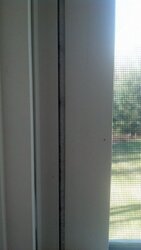There are numerous discussion threads on this forum about moving heat from one room to the next when using our wood burning appliances.
We have a 1410 sq ft bungalow with a circular floor plan. The stove is literally in one corner of the house.
Our first couple of seasons with our pellet stove were less than satisfying. We'd been told that the stove would run us out of this house. Didn't happen- not the first year, nor the second year- not until we got a lot more serious about our insulation. (That's a whole other thread.)
Turns out that the first couple of years, our problem really wasn't moving the heat around- it was keeping the heat in the house. Insulation has helped a lot.
On colder nights we will put a box fan on the floor in the room with the stove, aimed at the stove, to facilitate and augment the natural convection currents. The box fan pulls cold air along the floor from the rest of the house into the stove room, and this displacement of air pushes warm air out of the top of the room and into the rest of the house. We believe that this works- we can feel the heat rolling out of that room, and we can feel the other end of the house warm up.
Sometimes, if we are sitting in the living room (the stove is in another room) the air displacement from the box fan is noticeable. It feels cooler while sitting down in the living room, because the cool air is moving past us quickly.
It's pretty chilly here tonight, it's 28'F outside right now. We are burning Turman's this evening. The stove room is holding at 72.5'F. The rest of the house is holding at 67'F. (We normally keep the gas furnace set at 65'F so this is a warmer temp than we'd pay to run the gas furnace.)
Tonight, for some reason, it finally occured to me to do the toilet paper test. I just took a roll of toilet paper and a roll of tape and taped a strip of toilet paper in the doorway of each room of the house. I turned the box fan OFF so we could see the natural convection currents.
Wow. Wow. Insane. We can *see* the air moving, and it *is* moving. A lot. NEWSFLASH: HEAT IS MOVING ITSELF THROUGH THE HOUSE ON ITS OWN. I am now more convinced than ever that the best thing we can do is hang onto the BTUs rather than trying to move them aggressively from room to room.
The air movement on its own, without the box fan assist, is pretty impressive. Gonna check it again with the box fan running, but given this visual, I'm going to leave the box fan off more than on, I think.
We have a 1410 sq ft bungalow with a circular floor plan. The stove is literally in one corner of the house.
Our first couple of seasons with our pellet stove were less than satisfying. We'd been told that the stove would run us out of this house. Didn't happen- not the first year, nor the second year- not until we got a lot more serious about our insulation. (That's a whole other thread.)
Turns out that the first couple of years, our problem really wasn't moving the heat around- it was keeping the heat in the house. Insulation has helped a lot.
On colder nights we will put a box fan on the floor in the room with the stove, aimed at the stove, to facilitate and augment the natural convection currents. The box fan pulls cold air along the floor from the rest of the house into the stove room, and this displacement of air pushes warm air out of the top of the room and into the rest of the house. We believe that this works- we can feel the heat rolling out of that room, and we can feel the other end of the house warm up.
Sometimes, if we are sitting in the living room (the stove is in another room) the air displacement from the box fan is noticeable. It feels cooler while sitting down in the living room, because the cool air is moving past us quickly.
It's pretty chilly here tonight, it's 28'F outside right now. We are burning Turman's this evening. The stove room is holding at 72.5'F. The rest of the house is holding at 67'F. (We normally keep the gas furnace set at 65'F so this is a warmer temp than we'd pay to run the gas furnace.)
Tonight, for some reason, it finally occured to me to do the toilet paper test. I just took a roll of toilet paper and a roll of tape and taped a strip of toilet paper in the doorway of each room of the house. I turned the box fan OFF so we could see the natural convection currents.
Wow. Wow. Insane. We can *see* the air moving, and it *is* moving. A lot. NEWSFLASH: HEAT IS MOVING ITSELF THROUGH THE HOUSE ON ITS OWN. I am now more convinced than ever that the best thing we can do is hang onto the BTUs rather than trying to move them aggressively from room to room.
The air movement on its own, without the box fan assist, is pretty impressive. Gonna check it again with the box fan running, but given this visual, I'm going to leave the box fan off more than on, I think.




